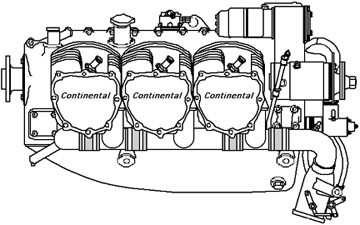Comment Period Re-Opened Through February 23
The FAA is proposing to revise an earlier proposed airworthiness directive (AD) for certain Airmotive Engineering Corp. (AEC) replacement parts manufacturer approval (PMA) cylinder assemblies marketed by Engine Components International Division (ECi).

These cylinder assemblies are used on all Continental Motors, Inc. (CMI) model 520 and 550 reciprocating engines, and on all other CMI engine models approved for the use of model 520 and 550 cylinder assemblies, such as the CMI model 470 when modified by supplemental type certificate (STC). The NPRM proposed to require initial and repetitive inspections, replacement of cracked cylinder assemblies, and replacement of cylinder assemblies at reduced times-in-service. The NPRM also proposed to prohibit the installation of affected cylinder assemblies into any engine. The NPRM was prompted by reports of multiple cylinder head-to-barrel separations and cracked and leaking aluminum cylinder heads.
This supplemental NPRM (SNPRM) modifies the schedule for removal of the affected cylinder assemblies, adds that overhauled affected cylinder assemblies be removed within 80 hours, eliminates a reporting requirement, and removes the requirement for initial and repetitive inspections. The FAA is proposing this SNPRM to prevent failure of the cylinder assemblies, which could lead to failure of the engine, in-flight shutdown, and loss of control of the airplane. Accordingly, the agency is reopening the comment period to allow the public the chance to comment on the proposed changes to the NPRM.
The original NPRM amended 14 CFR part 39 by adding an AD that would apply to certain AEC replacement PMA cylinder assemblies marketed by ECi. These assemblies are used on CMI model 520 and 550 reciprocating engines, and all other CMI engine models approved for the use of models 520 and 550 cylinder assemblies such as the CMI model 470 when modified by STC. The NPRM published in the Federal Register on August 12, 2013 (78FR 48828). The NPRM proposed to require initial and repetitive inspections, immediate replacement of cracked cylinder assemblies, and replacement of cylinder assemblies at reduced times-in-service (TIS) since new. The NPRM also proposed to prohibit the installation of affected cylinder assemblies into any engine.

Since the NPRM published on August 12, 2013 (78 FR 48828), the FAA received numerous comments on the proposed rule. The FAA reviewed those comments and considered their impact to safety. Some of those comments included additional failure information that the FAA subsequently incorporated in our updated risk analysis.
Following our comment review, the FAA determined that it needed to review how the FAA proposed to address the unsafe condition. So, the FAA formed a multi-directorate/multi-disciplinary team to review the technical basis of the proposed rule, as well as the numerous public comments, and the additional failure information provided by commenters, to the NPRM. This team confirmed that the subject cylinder assemblies are unsafe.
The team's review of the new data provided by commenters supports a lengthier compliance interval. This team therefore recommended several changes to the NPRM, which resulted in this SNPRM.
While the FAA remains steadfast that the cylinders represent a safety concern, the revised NPRM removes the 50 hour repetitive inspection requirement in the NPRM (78 FR 48828, August 12, 2013). The action was taken because it was determined that the inspection, compression test, and leak check proposed by the NPRM was not effective in detecting cracked cylinders. Based on further review of service information, it was determined that a compression test and leak check will not identify a crack until the crack has propagated all the way through the cylinder wall to some detectable location. Therefore, the agency is relying on the phased removal of the cylinders along with annual or 100-hour inspections already required by other regulations to provide an adequate level of safety.
The requirement to report details of all cylinder assemblies removed per the requirements of the AD to the FAA was also removed. This information is no longer needed since the agency will rely on our established reporting channels, e.g., Service Difficulty Reporting (SDR) and Malfunction/Defect (M/D) reports, to report future cylinder head failures.
 Sierra Space Repositions Dream Chaser for First Mission
Sierra Space Repositions Dream Chaser for First Mission ANN's Daily Aero-Term (05.10.24): Takeoff Roll
ANN's Daily Aero-Term (05.10.24): Takeoff Roll Aero-News: Quote of the Day (05.10.24)
Aero-News: Quote of the Day (05.10.24) Aero-News: Quote of the Day (05.11.24)
Aero-News: Quote of the Day (05.11.24) ANN's Daily Aero-Term (05.11.24): IDENT Feature
ANN's Daily Aero-Term (05.11.24): IDENT Feature




